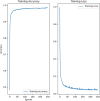COVision: convolutional neural network for the differentiation of COVID-19 from common pulmonary conditions using CT scans
- PMID: 38017408
- PMCID: PMC10683202
- DOI: 10.1186/s12890-023-02723-x
COVision: convolutional neural network for the differentiation of COVID-19 from common pulmonary conditions using CT scans
Abstract
With the growing amount of COVID-19 cases, especially in developing countries with limited medical resources, it is essential to accurately and efficiently diagnose COVID-19. Due to characteristic ground-glass opacities (GGOs) and other types of lesions being present in both COVID-19 and other acute lung diseases, misdiagnosis occurs often - 26.6% of the time in manual interpretations of CT scans. Current deep-learning models can identify COVID-19 but cannot distinguish it from other common lung diseases like bacterial pneumonia. Concretely, COVision is a deep-learning model that can differentiate COVID-19 from other common lung diseases, with high specificity using CT scans and other clinical factors. COVision was designed to minimize overfitting and complexity by decreasing the number of hidden layers and trainable parameters while still achieving superior performance. Our model consists of two parts: the CNN which analyzes CT scans and the CFNN (clinical factors neural network) which analyzes clinical factors such as age, gender, etc. Using federated averaging, we ensembled our CNN with the CFNN to create a comprehensive diagnostic tool. After training, our CNN achieved an accuracy of 95.8% and our CFNN achieved an accuracy of 88.75% on a validation set. We found a statistical significance that COVision performs better than three independent radiologists with at least 10 years of experience, especially in differentiating COVID-19 from pneumonia. We analyzed our CNN's activation maps through Grad-CAMs and found that lesions in COVID-19 presented peripherally, closer to the pleura, whereas pneumonia lesions presented centrally.
Keywords: COVID-19; Computational Medicine; Computer Vision; Convolutional Neural Network; Deep Learning.
© 2023. The Author(s).
Conflict of interest statement
The authors declare no competing interests.
Figures








Similar articles
-
PAM-DenseNet: A Deep Convolutional Neural Network for Computer-Aided COVID-19 Diagnosis.IEEE Trans Cybern. 2022 Nov;52(11):12163-12174. doi: 10.1109/TCYB.2020.3042837. Epub 2022 Oct 17. IEEE Trans Cybern. 2022. PMID: 34428169 Free PMC article.
-
Computed tomography-based COVID-19 triage through a deep neural network using mask-weighted global average pooling.Front Cell Infect Microbiol. 2023 Mar 3;13:1116285. doi: 10.3389/fcimb.2023.1116285. eCollection 2023. Front Cell Infect Microbiol. 2023. PMID: 36936770 Free PMC article.
-
CNN-RNN Network Integration for the Diagnosis of COVID-19 Using Chest X-ray and CT Images.Sensors (Basel). 2023 Jan 25;23(3):1356. doi: 10.3390/s23031356. Sensors (Basel). 2023. PMID: 36772394 Free PMC article.
-
An automated diagnosis and classification of COVID-19 from chest CT images using a transfer learning-based convolutional neural network.Comput Biol Med. 2022 May;144:105383. doi: 10.1016/j.compbiomed.2022.105383. Epub 2022 Mar 10. Comput Biol Med. 2022. PMID: 35290811 Free PMC article.
-
A multi-scale gated multi-head attention depthwise separable CNN model for recognizing COVID-19.Sci Rep. 2021 Sep 10;11(1):18048. doi: 10.1038/s41598-021-97428-8. Sci Rep. 2021. PMID: 34508120 Free PMC article.
References
-
- WHO Coronavirus (COVID-19) Dashboard. url: https://covid19.who.int/.
-
- COVID-19 Lung Damage. url: https://www.hopkinsmedicine.org/health/conditions-and-diseases/coronavir....
MeSH terms
LinkOut - more resources
Full Text Sources
Medical

